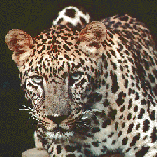
 |
Wim van Binsbergen at the Research Institute for Humanity and Nature (RIHN) and Harvard (Department of Sanskrit and Asian Studies) pre-symposium on Ethnogenesis of South and Central Asia (6-8 June 2005) and at Kyoto University Graduate School of Asian and African Area Studies (10-14 June 2005) |
return to topicalities 2004-2005 page
RIHN/Harvard conferenceWim van Binsbergen's participation in the 6th Harvard (Department of Sanskrit and Asian Studies) Round Table on Asian Ethnogenesis and Myth, May 2004, led to him being invited to participate in the 7th Round Table, this time in Kyoto, Japan, and organised jointly by the Kyoto Research Institute for Humanity and Nature (RIHN) and Harvard, under the title 'Pre-symposium on Ethnogenesis of South and Central Asia' (6-8 June 2005; click here for the conference programme). The conference attracted delegates from Japan, India, Pakistan, China, Laos, Australia, the USA, the UK, the Netherlands, Estonia, Finland, and other countries. The disciplines represented ranged widely from palaeobotany, genetics, archaeology and epigraphy, to linguistics, Sanskrit studies, anthropology, comparative mythology and intercultural philosophy. Major sections of the conference were devoted to new developments in Indus civilisation studies, new perspectives on the origin of agriculture, and new approaches to comparative mythology. The comparative mythology section was convened by Professor Michael Witzel of Harvard, USA (now visiting professor at Tokyo, Japan), who was also one of the convenors of the conference in general, along with RIHN Professors Osada (Munda linguist) and Sato (rice microbiologist). Michael Witzel has recently pioneered a long-range approach to world mythology as a major perspective on mankind's early history in its own right, in addition to such insights as can be offered by genetics, archaeology, linguistics and anthropology. In this context Wim van Binsbergen, whose life-long interest on myth has recently been intensified in his current research, presented a paper entitled (click here for abstract; and click here for a preliminary but book-length revised version of the full paper -- reflecting recent advances in the research he is currently undertaking within the research programme of the Theme Group on Agency in Africa, of the African Studies Centre, Leiden, the Netherlands.Wim van Binsbergen's speculative paper was extremely audacious, seeking to reconstruct humankind's oldest discours across 140,000 years, and providing, in the proicess, an interpretative and classificatory scheme for all world mythology as developed subsequently. In line with the philosopher Cassirer and later studies, the argument takes the position that myth is not mere embellishment of a socio-cultural life already effectively founded on other principles (e.g. material techniques of food and shelter), but that myth, on the contrary, is fundamentally constitutive of socio-cultural life of Anatomically Modern Man, and probably the latter's main claim to evolutionary advantage over earlier homonid forms. In order to prevent the attempt from remaining mere science fiction, most of the paper was taken up with questions of methodology. Thanks to Michael Witzel's gracious chairmanship, this complex and lengthy paper (the only one in the entire conference to adopt an African perspective) was allowed very generous presentation time at the conference. This resulted in enthusiastic reception from many specialists present, ranging from archaeologists and geneticists to linguists and comparative mythologists. This suggests the paper to be a genuine advance in comparative mythology and in the reconstruction of the earliest human thought. |
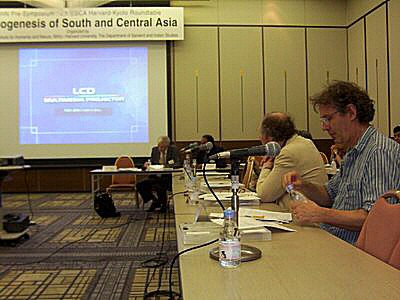 General view of the conference venue
A. Parpola, a major exponent of Indus civilisation studies
The opening address by Prof. Hidaka, Director-General of RIHN; to the right Michael Witzel
access to the Paruru conference centre
Lightning is one of the basic cosmogonic mythical concepts attested throughout world mythology, and argued, in Wim van Binsbergen's paper, to have been part of the original 'Out of Africa' package with which Anatomically Modern Man left Africa, c. 140,000 years ago. It can also be argued to have continued to underly the essentially cosmogonic, hence innovative and meta-structural conception of agency in Africa right up to today. |
 Professor Goto from a Northern Japanese University, an Erlangen (Germany) PhD and a major specialist on Indo-European mythology whose paper converged unexpectedly but massively with Wim van Binsbergen's recent analysis of the Dioscuri and bird symbolism of the Sea Peoples (Late Bronze Age Mediterranean), part of a book on Late Bronze Age Mediterranean ethnicity (written jointly with Fred Woudhuizen) now being finalised for publication with British Archaeological Reports
Richard Villems, from Estonia, whose paper on recent developments in the genetic reconstruction of the history of Anatomically Modern Man showed interesting parallels between the distribution of certain gclades and the distribution of the 'earth diver' mytheme in Northern Asia
Selected delegates with local support staff from RIHN
Kyoto's fabulous new station, adjacent to the conference venue
The basic 'Out of Africa' structure of world mythology as reconstructed and methodologically argued in Wim van Binsbergen's Kyoto 2005 paper |
|
Kyoto University Graduate School of Asian and African Area Studies (ASAFAS)After the conference, Wim van Binsbergen was the guest of Kyoto University Graduate School of Asian and African Area Studies (ASAFAS) from 10-14 June 2005. Here the director, Professor Shigeru Araki, soil scientist and specialist on Bemba agricultural systems, was Wim van Binsbergen's host, in a generous and congenial exchange based on mutual identification, during decades, with Zambia. After a pleasant introductory meeting with senior staff and attendance at Professor Phillip Tobias' occasional lecture on advances in palaeoanthropology in South Africa (sponsored by the South African Embassy), two full days were devoted to Wim van Binsbergen's master classes with nearly two dozen of the Centre's PhD candidates. Following once more the pattern employed in Cameroon in March 2005, each junior researcher would present her or his current research in some detail, after which Wim van Binsbergen's lengthy comments would generate a discussion that many declared, with characteristic Japanese politeness, to be highly inspiring and enlightening. What made these exchanges especially pleasant and rewarding was the fact that the Kyoto approach turned out to have three salient characteristics that place it in the forefront of African Studies today:
Most of the projects discussed were on
South Central Africa (Zambia, Zimbabwe, Malawi,
Tanzania), thus allowing Wim van Binsbergen to draw on
over three decades of personal research and publications,
with many of which the audience turned out to be
familiar. On Monday, 13 June, a two-hour lecture was
embedded in the master class, entitled 'Globalisation,
religion, and apparently irrational practices: An
Africanist perspective', reflecting Wim van Binsbergen
long-standing work on globalisation, virtuality and African
religion, and tying in with
research questions currently highlighting in ongoing work
at the Kyoto University Graduate School of Asian and
African Area Studies (ASAFAS). |
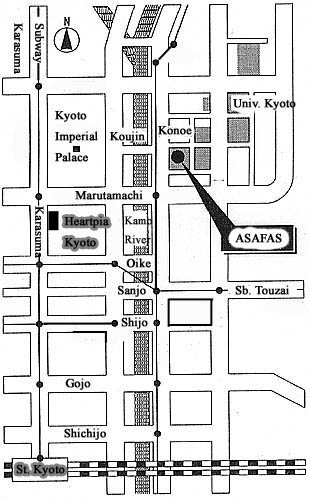 ASAFAS situated at 4 km northeast of Kyoto Station
Octogenarian Emeritus Professor Phillip Tobias from Witwatersrand fondly handling a cast of the Taung Child (2.5 million years old), during his occasional lecture at Kyoto University |
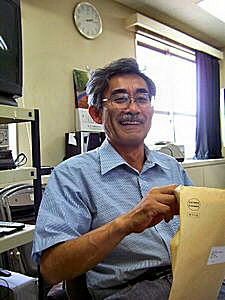 Professor Araki
the day preceding the student's annual party, the ASAFAS seminar room is converted into a kitchen! |
|
| Thanks to
the efforts of Prof. Araki and his staff, the globalised
hotel accomodation that had been enjoyed earlier during
the conference, could be exchanged for a succession of
famous Zen Buddhist temples offering traditional
accommodation and hospitality, as well as selected ritual
practices, to mainly Japanese guests. Three graduate students had been entrusted with designing a tour along Kyoto's historical sites geared specifically to what had been gleaned from Wim van Binsbergen's website and published work as his special interests: divination and spiritual environmental orientation (Feng Shui). The result was a uniquely intensive encounter with traditional Japan from a modern local Japanese perspective. |
 table after dinner at the Ninna-ji temple
morning service at the Ninna-ji temple in the pouring rain
two competent and well-prepared guides
high religion (the Kiyomizudera temple complex overlooking Kyoto)
at the Kiyomizudera temple, at long last I gather first-hand experience of the milfoil-stalk oracle that, interpreted with a catalogue derived from the Ancient Chinese Book of Changes (Yi King), appears to be at the origin of many Arabian and sub-Saharan African divination systems
my morning view in the land of the rising sun, at the Myosinji temple Daishin'in |
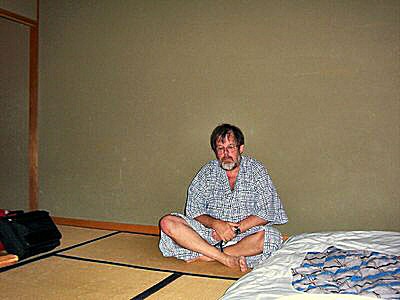 'and so to bed' (Pepys)
before the Ninna-ji temple premises are opened to the public
Wim van Binsbergen worshiping at the shrine of Seimei -- son of the vixen goddess Inari, and designer of Kyoto's protective feng shui layout as imperial city; the shrine straddles the city's protective boundary and the bridge of spirits
alternating with low religion (the Jishu good luck shrine)
Zen gardens define the spiritual context of the Daishin'in ('imperial court') accommodation, part of the Myosinji temple complex |
return to topicalities 2004-2005 page
 click
the image to return |
||||
|
 |
 |